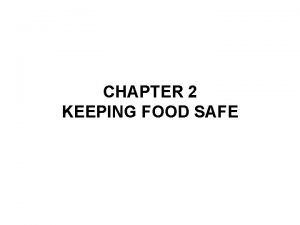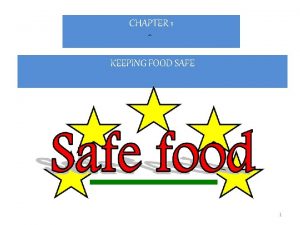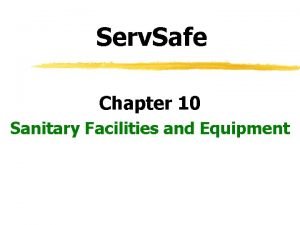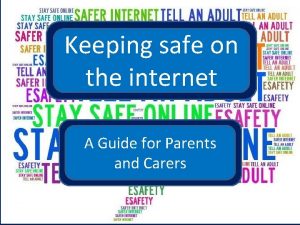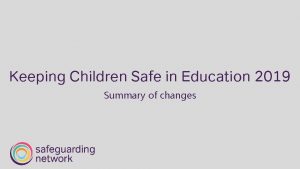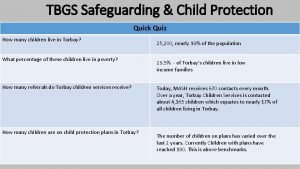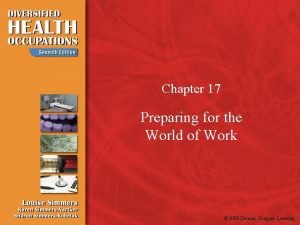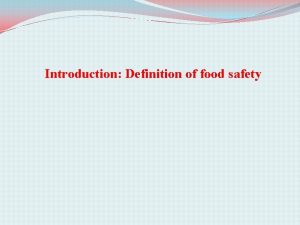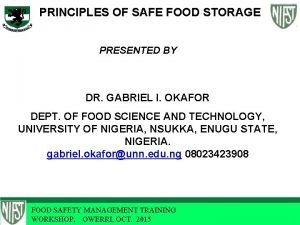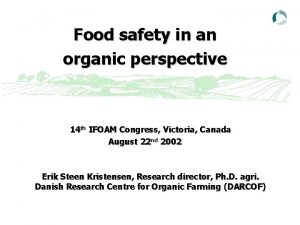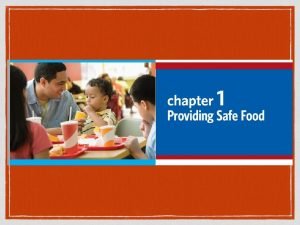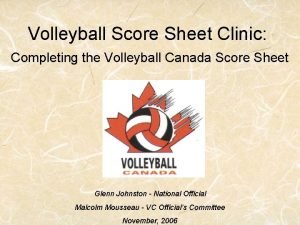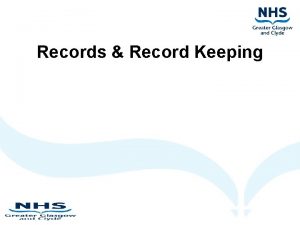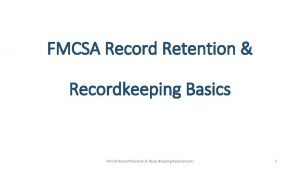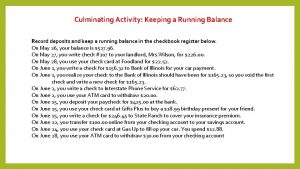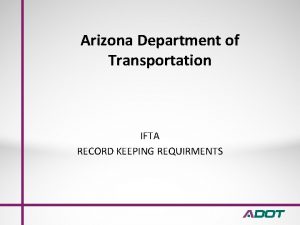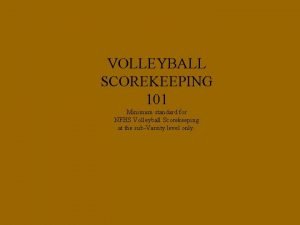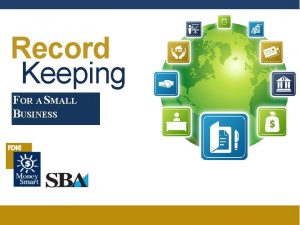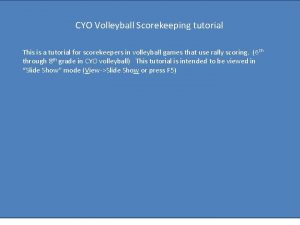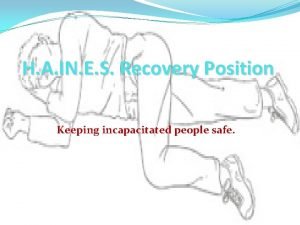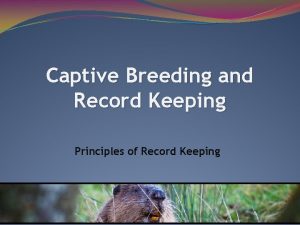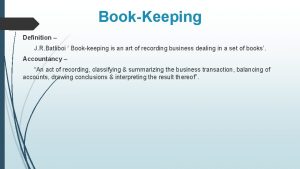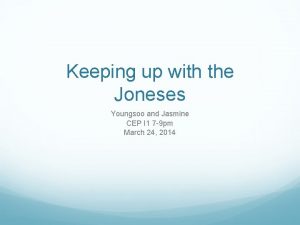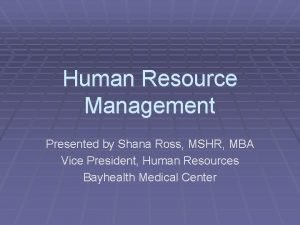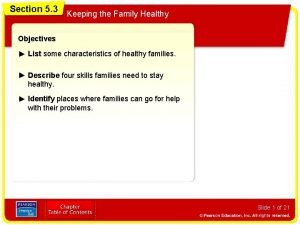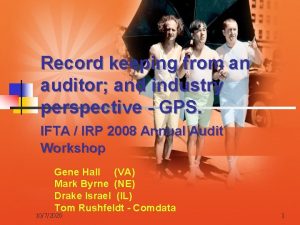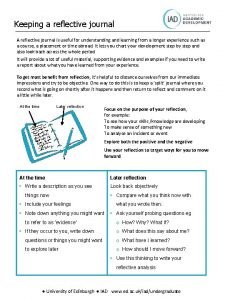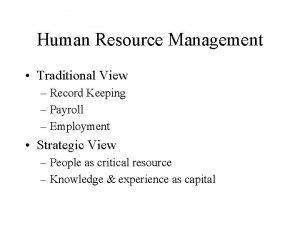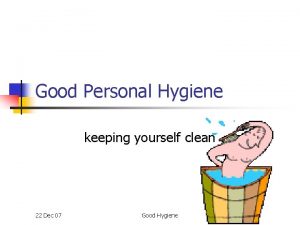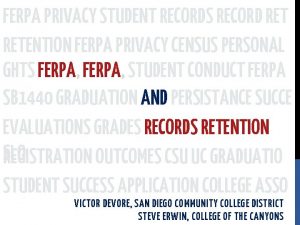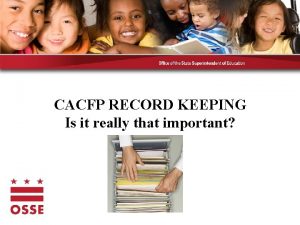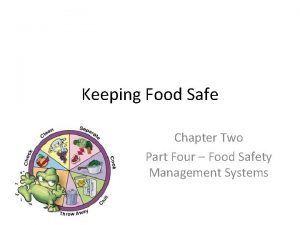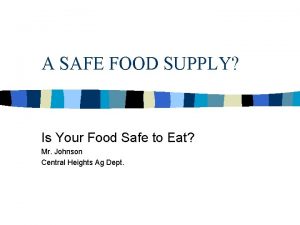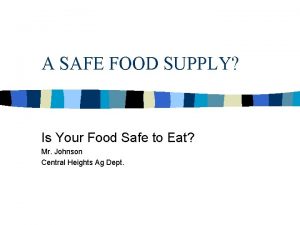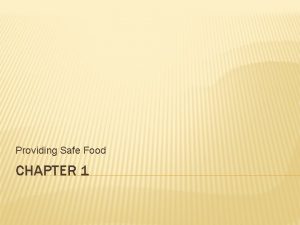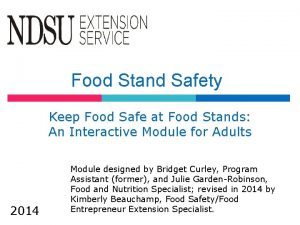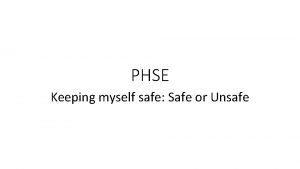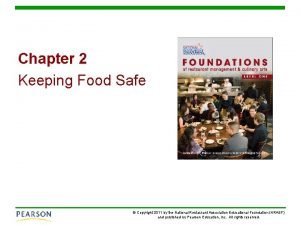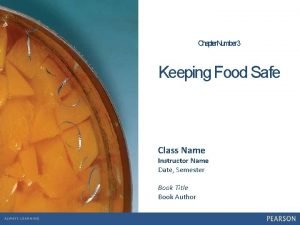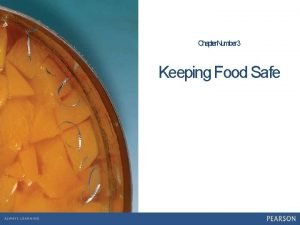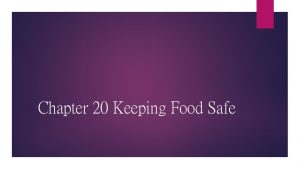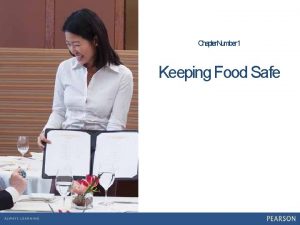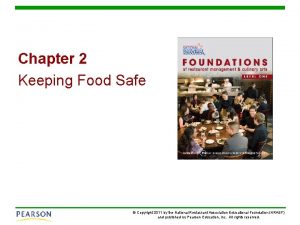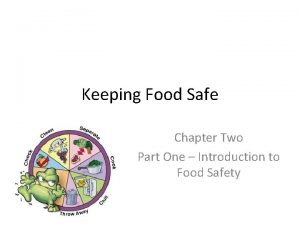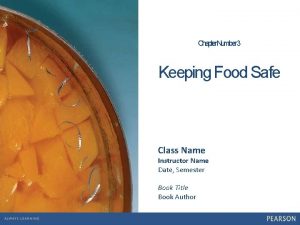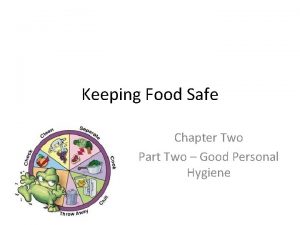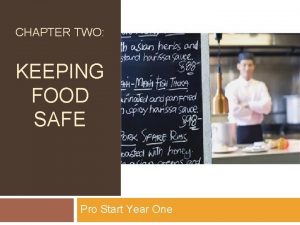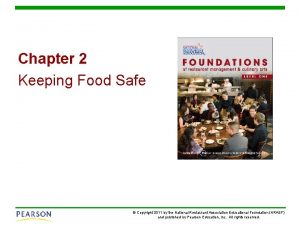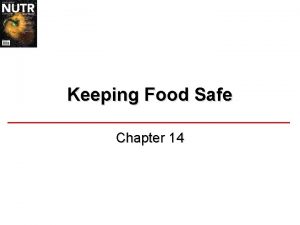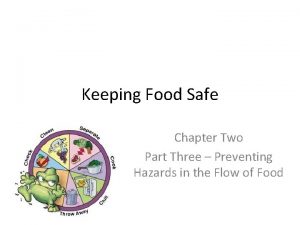CHAPTER 2 KEEPING FOOD SAFE Chapter 2 Level




































































- Slides: 68

CHAPTER 2 KEEPING FOOD SAFE

Chapter 2 Level 1 Keep Food Safe Learning Objectives In Section 2. 1, you learned the following: A foodborne illness is a disease transmitted to people by food. A foodborne-illness outbreak is when two or more people get the same illness after eating the same food. The leading Know types of foodborne illness p 81 The costs of a foodborne-illness outbreak include financial costs to the restaurant or foodservice operation and human costs: loss of time at work, medical expenses, long-term disability, and possibly death. P. 80 High-risk populations include people with weakened immune systems: the elderly, infants, preschool-age children, pregnant women, and people with HIV/AIDS or cancer, as well as people on chemotherapy and transplant recipients. They have a higher risk of getting a foodborne illness. Pathogens need six conditions to grow. These conditions can be remembered by FAT TOM: food, acidity, temperature, time, oxygen, and moisture. P. 79 Those foods that need time and temperature control for safety, such as milk or fish, are called TCS foods p. 80. Ready-to-eat food also needs careful handling to prevent contamination. Know how to handle and cool TCS Food P. 105 Contamination from biological toxins can be prevented by purchasing from approved, reputable suppliers and then cooking and holding dishes correctly. To store chemicals properly, you must keep them in a separate area away from food, utensils, and equipment used for food. Then follow safe storage rules. A food defense system helps to prevent people from purposely contaminating food. One important way to prevent tampering is to make sure access to an operation's food is controlled through use of uniforms and name tags. The most common allergens include milk and dairy products, eggs and egg products, fish, shellfish, wheat, soy, peanuts, and tree nuts. To prevent allergic reactions, servers must be able to answer questions about any ingredients in menu items. In addition, kitchen employees must be sure that allergens are not transferred by cross-contact. The restaurant and foodservice industry is monitored by many agencies. The FDA writes the FDA Food Code, and each state adopts the code as it sees fit. State and local health departments then enforce these laws. .

In Section 2. 2, you learned the following: The following personal behaviors of foodhandlers can contaminate food: Having a foodborne illness Having wounds that contain a pathogen Having contact with a person who is ill Touching the hair, face, or body and then not washing their hands Touching anything that may contaminate their hands and not washing them Having symptoms such as diarrhea, vomiting, or jaundice Eating, drinking, smoking, or chewing gum or tobacco while preparing or serving food The steps to proper handwashing are as follows: Wet hands and arms with running water as hot as you can comfortably stand (at least 100°F). Apply enough soap to build up a good lather. Scrub hands and arms vigorously for 10 to 15 seconds. Clean under fingernails and between fingers. Rinse hands and arms thoroughly under running water. Dry hands and arms completely with a single-use paper towel or warm-air hand dryer.

Hands should be washed before starting work. They also must be washed after these activities: using the restroom; handling raw meat, poultry, or seafood; touching the hair, face, or body; sneezing, coughing, or using a tissue; eating, drinking, smoking, or chewing gum or tobacco; handling chemicals that might affect food safety; taking out garbage; clearing tables or busing dirty dishes; touching clothing or aprons; handling money; and touching anything else that may contaminate hands. Personal cleanliness practices include bathing or showering before work, keeping hair clean, wearing clean clothes, removing jewelry from hands and arms, and keeping nails clean. Proper work attire includes always covering hair, wearing clean clothes, removing aprons and storing them in the right place after leaving the prep area, and removing jewelry from hands and arms. Using bare hands to handle ready-to-eat food can increase the risk of contaminating it. Use gloves, tongs, or deli tissue when handling ready-to-eat food. Employees shouldn't work with or around food when they have a sore throat with a fever. They should be prevented from being in the operation when they are vomiting, have diarrhea or jaundice, or have a foodborne

In Section 2. 3, you learned the following: Cross-contamination can be prevented by making sure workstations, cutting boards, and utensils are clean and sanitized; not allowing ready-to-eat food to touch surfaces that have come in contact with raw meat, seafood, or poultry; preparing different kinds of foods at different times; and cleaning and sanitizing work surfaces and utensils between each product. P 115 To prevent time-temperature abuse, minimize the amount of time that food spends in the temperature danger zone. Three types of thermometers commonly used in operations are bimetallic stemmed thermometers, thermocouples, and thermistors. In addition, infrared thermometers use infrared technology to produce accurate external temperature readings of food and equipment surfaces. An approved food source (supplier) is one that has been inspected and meets all applicable local, state, and federal laws. All TCS foods must be stored at 41°F or lower or at 135°F or higher. Label all ready-to -eat TCS food prepped in-house that will be held for more than 24 hours. These foods can be stored in-house for a maximum of seven days at 41°F or lower. Rotate food to use the oldest inventory first, and wrap or cover food. Refrigerate raw meat, poultry, and seafood separately from ready-to-eat food. Store raw meat, poultry, and seafood in coolers in the following top-to-bottom order: seafood on top, then whole cuts of beef and pork, then ground meat and ground fish, and at the bottom, whole and ground poultry.

The criteria for accepting or rejecting food during receiving are as follows: Temperature: Cold TCS should be 41°F or lower, hot TCS should be 135°F or higher, and frozen food should be frozen. Reject any frozen food that has ice crystals on the product or packaging or if any fluids or frozen liquids appear in the bottom of its case. Packaging: For both food and nonfood items, packaging should be intact and clean. Reject any item that has a package with tears, holes, punctures, leaks, dampness, water stains, signs of pest damage, or an expired use-by date. Product quality: Reject any food that has an abnormal color, slimy or sticky texture, soft flesh that leaves an imprint when you touch it, or abnormal or unpleasant odor. Shellfish: Raw, shucked shellfish are packaged in containers for one-time use only. Containers must be labeled with the packer's name, address, and certification number. Live shellfish must be received with identification tags. Employees must write on the tags the date that the last shellfish was sold or served from the container, and keep the tags as records. Reject shellfish if they are muddy, have broken shells, or are dead. Eggs: Shell eggs must be clean and unbroken. Reject shell eggs received at an air temperature higher than 45°F. Milk and dairy products: These products must be received at 41°F or lower unless otherwise specified. They must be pasteurized and meet FDA Grade A standards.

The following are minimum internal temperature requirements for cooking TCS foods: 165°F for 15 seconds: Poultry, stuffing made with TCS ingredients, stuffed meat/seafood/poultry/pasta, dishes that include previously cooked TCS ingredients 155°F for 15 seconds: Ground meat, injected meat, ground seafood, eggs that will be hot-held for service 145°F for 15 seconds: Seafood, including fish, shellfish, and crustaceans; steaks/chops of pork, veal, and lamb; eggs that will be served immediately 145°F for 4 minutes: Roasts of pork, beef, veal, and lamb 135°F: Commercially processed ready-to-eat food that will be hot-held for service; fruits, vegetables, grains, and legumes that will be hot-held for service

Hold hot TCS food at 135°F or higher, and hold cold TCS food at 41°F or lower. Cool TCS food from 135°F to 41°F or lower within six hours-135°F to 70°F within the first two hours, and then to 41°F or lower in the next four hours. Reheat TCS food for hot-holding by heating it from storage temperature to an internal temperature of 165°F in less than two hours. Then make sure that the food stays at that temperature for 15 seconds. Kitchen staff should handle ready-to-eat food with tongs, deli sheets, or gloves; use separate utensils for each item; clean and sanitize after each serving task; and store serving utensils in the food with the handle extended above the rim of the container. The service staff should hold dishes by the bottom or edge; hold glasses by the middle, bottom, or stem; carry glasses in a rack or on a tray; hold flatware by the handle; store flatware so servers grasp handles; minimize barehand contact with ready-to-eat food; and use ice scoops or tongs to get ice. Food prepared and served off-site must be packed in insulated food containers and checked for internal food temperature regularly. The vehicle used to transport food must be clean.

In Section 2. 4, you learned the following: The HACCP principles are as follows: Principle 1: Conduct a hazard analysis Principle 2: Determine critical control points (CCPs) Principle 3: Establish critical limits Principle 4: Establish monitoring procedures Principle 5: Identify corrective action Principle 6: Establish verification procedures Principle 7: Establish procedures for record keeping and documentation A HACCP system is important because it focuses on identifying specific points within a food item's flow through the operation that are essential to prevent, eliminate, or reduce hazards to safe consumption.

Define foodborne illness and how many people have to become ill before it is defined as foodborne illness. • A foodborne illness is a disease transmitted to people by food. A foodborne-illness outbreak is when two or more people get the same illness after eating the same food. The leading Know types of foodborne illness p 81

According the Centers for Disease Control (CDC), how many cases of foodborne illness are there in the United States every year? (75) • 76 Million

The CDC estimates that how many people die annually due to foodborne illness? (75) • 5, 000

Please tell me about the 4 high risk populations that are more at risk of contracting a foodborne illness. (77) • • Elderly Infant & Preschool Age Children Pregnant Women People with cancer or on chemo, people with HIV, or transplant recipients

Why are infants and pre-school age children at a higher risk for foodborne illness? (77) • Their body had yet to build a strong immune system.

What are pathogens? (77) • Microorganisms that cause illness

Hazards to foods are broken into 3 categories. What are those 3 categories? (77) • Biological • Chemical • Physical

What is contamination? (77) • Harmful things are present in food

What is cross-contamination? (77) • Transfer of pathogens from one surface to another

What is the definition of a microorganism? (78) • Small, living organisms that can only be seen through a microscope.

What are the 4 types of pathogens that can contaminate food? (78) • • Viruses Bacteria Parasites Fungi

Please explain FAT TOM and what all of the letters stand for in the acronym. (78) • • • Food Acidity Temperature Time Oxygen Moisture

Soybeans, peanuts and tree nuts are dangerous for people with what kind of condition? (78) • Food Allergies

What is a TCS food? (78) • Foods that are the most vulnerable for pathogens.

What does TCS stand for? (78) • TCS stands for Time and Temperature Controlled for Safety

Most bacteria can be controlled by following this food safety practice. (79) • Keeping the food out of the temperature danger zone (TDZ)

Please give an example of a TCS food. • Chicken • Beef • Milk

What microorganism is the leading cause of foodborne illness? (81) • Virus

What are the best ways to prevent the spread of viruses? (81) • Stay home if you have been vomiting or have diarrhea or jaundice • Wash your hands at the right times and in the right way • Avoid using bare hands to handle ready to eat foods

Which type of food is commonly involved in foodborne illness outbreaks? • Ready–to–Eat Foods

What cannot grow in food and requires a host to grow? (82) • Parasite

A piece of glass found in the ice maker is an example of what kind of contamination? (85) • Physical

Food allergens come about because of a body’s negative reaction to what in food? (86) • Food Protein

90 percent of all food allergy reactions are due to: (86) • • Milk and Dairy Products Eggs and Egg Products Fish Shellfish Wheat Soy and Soy Products Peanuts Tree nut such as Pecans and Walnuts

What is cross contact? (87) • When allergens ate transferred from food containing allergens to the food served to the customer

The FDA writes this, which recommends specific food safety regulations for the restaurant and foodservice industry? (89) • FDA Food Code

What is the single most important part of personal hygiene? (96) • Handwashing

How long should it take for you to properly wash your hands? (97) • 20 seconds

Once soap has been applied, how long should foodhandlers scrub hands and arms? (98) • 10 to 15 seconds

Name a hand care practice, in addition to handwashing, that can prevent contamination. (99) • Keeping fingernails short and clean • Not wearing mail polish or false fingernails • Covering hand wounds with clean bandages and gloves or finger cots

Name a hand care practice, in addition to handwashing, that can prevent contamination. (99) • • When they are soiled or torn Before beginning a different task At least every 4 hours during continuous use After handling raw meat, seafood, or poultry and before handling ready to eat food

Name the symptoms that require a foodhandler to stay home from work. (100) • Sore throat with fever in an operattion that primarily serves a high risk population • Diarrhea • Vomiting • Jaundice • Diagnosed with certain foodborne illness

Bacteria grow especially fast in what temperature range? (105) • 70 – 125 degree Fahrenheit

List 4 ways to prevent cross contamination. (105) • Workstations, cutting boars, and utensils are clean and sanitized • Not allowing ready to eat food to touch surfaces that have come in contact with raw meat, seafood or poultry • Preparing different kinds of foods at different times • Cleaning and sanitizing work surfaces and utensils between each product

How do you calibrate a bimetallic stemmed thermometer? (106) • Place into a container with ice and just enough water to make it float. • Set to 32 degrees using the set screw under the face of the dial.

Please describe a bimetallic stemmed thermometer. (106) • They have a stem with a dial on top that has a temperature range of 0 – 220 degrees.

Name the 2 requirements for a supplier to be considered an approved food supplier. (108) • They must be inspected • They must be in compliance with applicable local, state and federal laws

Deliveries of cold TCS food should be at what temperature? (109) • Cold Foods – 41 degrees or lower

Deliveries of hot TCS food should be at what temperature? (109) • Hot Foods – 135 degrees or higher

How do shell fish need to be labeled? (110) • Packer’s Name • Packer’s Address • Certification Number • Containers of less than ½ gallon or smaller must have a” Best If Used By” or “Sell By” date.

Live shellfish must be received with tags. How long do restaurants need to keep the tags? (111) • 90 days from the time the last shellfish was served.

Eggs must be received at what AIR temperature? (111) • 45 degrees or lower

What is the temperature requirement for receiving milk products? (111) • 41 degrees or lower

Which product must have a USDA inception mark and must comply with USDA grade standards to be acceptable for receiving? (111) • Eggs

Please tell me about the FIFO inventory control method. (111) • First In, First Out – Rotate food in storage to use the oldest inventory first.

TCS Foods must be thrown out after how many days? (111) • If it is produced in-house, it must be thrown away after 7 days.

What is the best way to thaw food safely? (113) • In a cooler with a product temperature of 41 degrees or lower

TCS foods need to be thawed in one of four ways: (113) • Cooler – Refrigerator • Submerged in running water of 70 degrees or lower • Microwave – It must be cooked immediately after thawing. • Thaw food as part of the cooking process.

Which temperature probe is used to check the internal temperature of thin foods? (114) • Penetration probe

What are the minimum internal cooking temperatures for the follow TCS food items? (115) • • • Poultry at 165 degrees for 15 seconds Ground Beef at 155 degrees for 15 seconds Seafood at 145 degrees for 15 seconds Pork Roasts at 145 degrees for 4 minutes Cheese Sticks at 135 degrees

Which temperature probe is used to check the internal temperature of thin foods? (114) • Beef roasts; 145 degrees for 4 minutes • Stuffed pork chops; 165 degrees for 15 seconds • Shell eggs for immediate service; 145 degrees for 15 seconds

When holding food in warmers, temperatures must be checked a minimum of how often? (116) • Every 4 Hours

What do you then need to do with any foods found to be in the temperature danger zone? (116) • Throw out

TCS food should be thrown out after how many hours in the temperature danger zone? (117) • 4 Hours

Please describe the complete process of cooling TCS foods. (117) • Cool TCS Foods from 135 to 70 degrees or lower within 6 hours. • Cool from 135 to 70 degrees within 2 hours • The food item must then be chilled to 41 degrees or lower in the next 4 hours.

How do you need to reheat foods to insure safety? (118) • The food needs t go from storage temperature to 165 degrees within 2 hours and stay at that temperature for 15 seconds.

What does HACCP stand for? (126) • Hazard Analysis Critical Control Point

List the 7 steps in a HACCP plan. • • Conduct a hazard analysis Determine critical control points (CCPs) Establish critical limits Establish monitoring procedures Identify corrective actions Verify that the system works Establish procedure for record keeping and documentation

What is the difference between cleaning and sanitizing? (135) • Cleaning removes food and other dirt from a surface. • Sanitizing reduces the pathogens on a surface to safe levels.
 Bimetallic stemmed thermometer definition
Bimetallic stemmed thermometer definition Potentially hazardous food is usually moist
Potentially hazardous food is usually moist Safe feed safe food
Safe feed safe food Keeping an infant safe and well section 7-3
Keeping an infant safe and well section 7-3 Keeping an infant safe and well section 7-3
Keeping an infant safe and well section 7-3 Servsafe cutting board colors
Servsafe cutting board colors Keeping safe on the internet
Keeping safe on the internet Keeping children safe in education 2019
Keeping children safe in education 2019 Ted safeguarding poster
Ted safeguarding poster Safe people safe places
Safe people safe places Unit 2 food food food
Unit 2 food food food Eltonian pyramid
Eltonian pyramid Draw the context level dfd for the safe home software.
Draw the context level dfd for the safe home software. Chapter 17:3 completing job application forms
Chapter 17:3 completing job application forms Chapter 11
Chapter 11 Definition of food safety
Definition of food safety Food storage principles
Food storage principles Danger zone food
Danger zone food Four steps to food safety
Four steps to food safety Definition of safe food
Definition of safe food Foodborne illness definition servsafe
Foodborne illness definition servsafe Volleyball score sheet canada
Volleyball score sheet canada Alliteration in keeping quiet
Alliteration in keeping quiet Hussain manawer poems
Hussain manawer poems Introductory paragraph for persuasive essay
Introductory paragraph for persuasive essay Legible meaning
Legible meaning Gap year poem
Gap year poem Keeping orchids jackie kay
Keeping orchids jackie kay Sentry function of journalism
Sentry function of journalism Fmcsa record retention
Fmcsa record retention Culminating activity keeping a running balance
Culminating activity keeping a running balance Cryptology an introduction to the art and science
Cryptology an introduction to the art and science Chapter 7 business management
Chapter 7 business management Situational audience analysis example
Situational audience analysis example An institution for receiving keeping and lending money
An institution for receiving keeping and lending money Record keeping and budgeting
Record keeping and budgeting Ifta record keeping requirements
Ifta record keeping requirements Is playing
Is playing Keeping score in volleyball
Keeping score in volleyball Keep the city cleanمعنی
Keep the city cleanمعنی Sweat lodges
Sweat lodges Simple record keeping for small business
Simple record keeping for small business Building keeping and growing profitable value-laden
Building keeping and growing profitable value-laden Record keeping and writing
Record keeping and writing Volleyball scorekeeping
Volleyball scorekeeping Bonang
Bonang How youre
How youre Es position
Es position Zoo record keeping systems
Zoo record keeping systems J r batliboi bookkeeping
J r batliboi bookkeeping Keeping healthy quiz
Keeping healthy quiz Keeping up with the joneses origin
Keeping up with the joneses origin Keeping the church pure
Keeping the church pure Orchids poem questions and answers
Orchids poem questions and answers Shana is keeping track of the expenses as deductions
Shana is keeping track of the expenses as deductions Ankle sprain soap note
Ankle sprain soap note Branch keeping full system of accounting are
Branch keeping full system of accounting are Identify four skills that families need to stay healthy.
Identify four skills that families need to stay healthy. Ifta record keeping requirements
Ifta record keeping requirements V
V Keeping your career on track
Keeping your career on track Keeping a reflective journal
Keeping a reflective journal Traditional record keeping
Traditional record keeping House keeping staff (hks)
House keeping staff (hks) Important of personal hygiene
Important of personal hygiene Ferpa record keeping requirements
Ferpa record keeping requirements Emotional love tank
Emotional love tank Cacfp record keeping requirements
Cacfp record keeping requirements Molecular level vs cellular level
Molecular level vs cellular level
